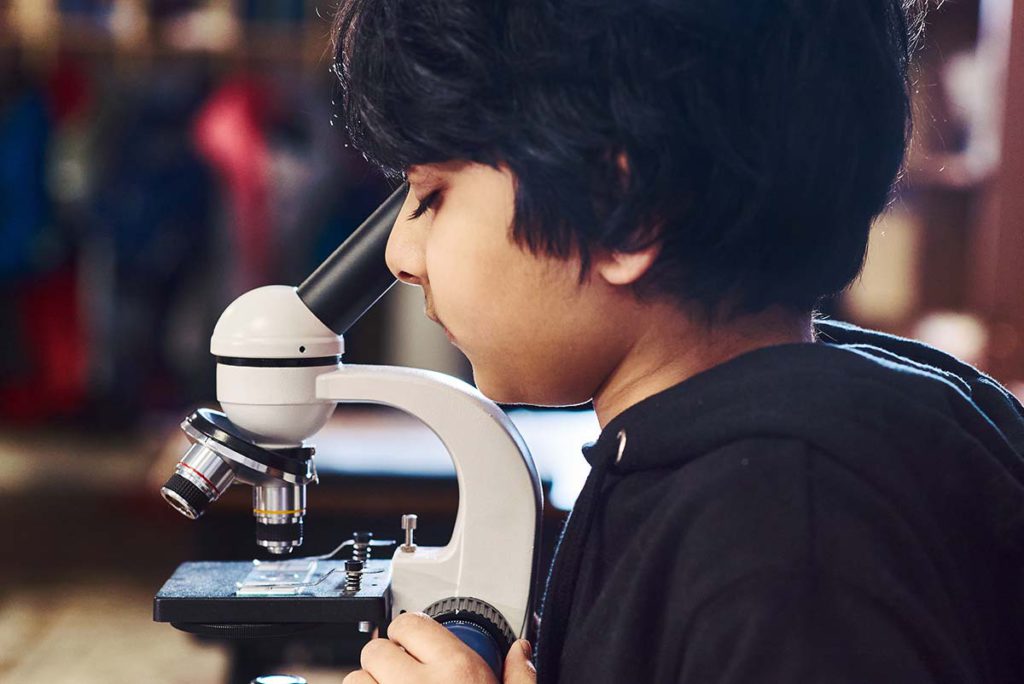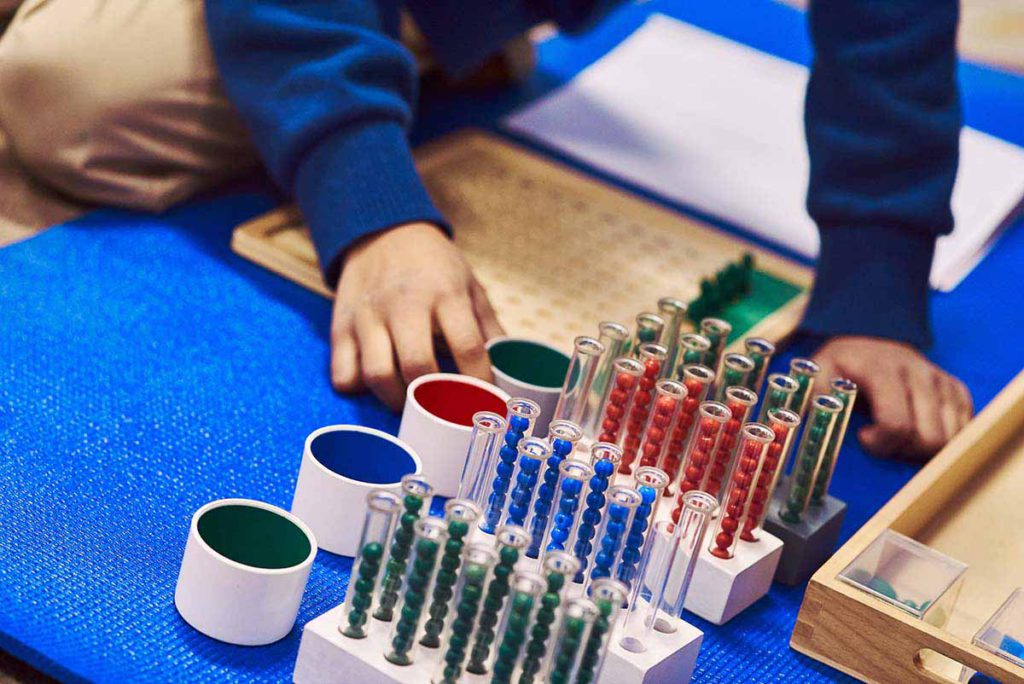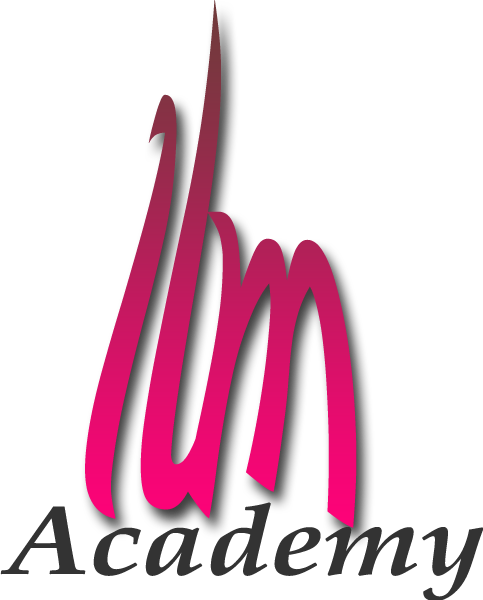upper elementary PROGRAM curriculum
9-12 Years
Following the guidelines of Dr. Maria Montessori’s developmentally relevant syllabus, the Montessori Upper Elementary curriculum fosters a deeper understanding of academic subjects. Students continue to develop academic skills and strong ethical sense through spiritual development. The curriculum is divided into three major areas as listed below:
- Cultural studies which are further categorized into life sciences (botany and zoology) and physical sciences (physics and chemistry), history, and geography
- Math and Geometry
- Language
Cultural
The cosmic curriculum is the foundation for the entire Montessori elementary environment. It refers to the interrelatedness of humanity and the earth. It is intended to help each of us search for our cosmic task as a species and as an individual. It gives a unitary vision of the world and explains the relationship and interdependence of living and nonliving organisms on earth.
Cosmic Education is interwoven into everything taught in a Montessori classroom. It is the concrete expression of studies in areas such as Biology, History, Geography, and Physical Science. The study of humans in the context of evolution and the natural world supports the interconnectedness that fuels our peace curriculum. The history lessons from the Timeline of Life lay the framework for our Botany and Zoology. The beauty of the Montessori Method is that nothing stands in isolation but instead works together to speak to the intellect and spirit of the whole person.
Botany and Zoology:
There are two major areas of biology. The first is zoology, which is the scientific study of animals, their structure, physiology, classification, and distribution. The second is botany, which is the study of the classification of plants, their physiology, their structure, their ecology, distribution, and economic importance. The students continue to deepen their knowledge of the biological world through experiences and interactions with plants and animals in the physical environment but it is not always possible to have access to such specimens.

Chemistry and Physics:
Students explore in detail the periodic table of the elements, their classification, and use. They use hands-on material to create atoms, molecules, and chemical equations such as that for photosynthesis. They conduct experiments, further exploring concepts such as acids and bases. The study of simple machines is also a focus during the Upper Elementary years. Examples of areas studied include gears and levers, pulleys, and inclined planes. Students also use hands-on material specially designed for classroom use to explore electric circuits and simple machines.

Geography and History:
Geography includes the beginning of the universe then categorizing and focusing on the creation of the Solar System, Earth, the continents, the natural biomes, and later the human constructs of political geography. Students dive deeper into physical geography by learning to identify more and varied physical features of both the United States and the world. They create many maps to accompany their various researches and studies. They also learn map-reading skills such as location using latitude and longitude, reading a map scale and legend, and becoming familiar with many types of maps.
Upper Elementary students also begin their history studies with the study of the formation of the Universe and the earth and specific periods of earth’s history. These time periods are now approached at a second and more detailed level, building on the work of the Lower Elementary years. All of this study is integrated with the areas of chemistry, astronomy, geology, and biology.
American History is studied in depth for over three years. The pre-Colonial, Colonial, and Revolutionary War Periods are reviewed in greater depth and integrated with reading through historical fiction. The famous series of the history for the classical child, “The Story of the World” by Susan Wise Bauer is used to present an interesting and complete narrative of U.S. history to the 21st century.

Math:
The Montessori child has room to stretch their wings in the elementary environment. In following the scope and sequence of the math curriculum, often beginning in primary, the operations will be sequenced in the order:
Addition,
Multiplication is a natural transition from addition.
Subtraction
Division
Additionally, these skills should be performed simultaneously:
Fractions
Money
Time
Measurement
Language:
The Upper Elementary Reading and Writing curriculum is designed to foster life-long reading, writing, and thinking skills. Through carefully structured activities and assignments, students gain the skills and understandings they need to be effective readers and writers for the remainder of their educational careers and beyond.
Reading:
Through our Reading program, Reading A to Z (RAZ), and weekly literature circles (novel study), we assist the students to build a good understanding of literary conventions and techniques. RAZ includes hand-selected texts for each topic supporting a high volume of reading, writing, and discussion. The students explore a variety of genres: realistic fiction, science fiction, fantasy, traditional literature, poetry, non-fiction, essay, newspaper, and magazine articles. Students learn and experiment with the elements of a story: character, plot (chronological order/flashback; conflict resolution and types of action including suspense, climax, coincidence); theme, setting (how the setting can act as an antagonist, or illuminate character); points of view (who is telling the story?); style (imagery, simile, metaphor, hyperbole), and tone. Students learn and apply reading, writing, grammar and word work, foundational, and speaking and listening skills in conjunction with weekly texts.
Writing:
Writing is taught systematically following the process of pre-writing, drafting, revising, editing, rewriting, and publishing/ presenting. Much of the writing that students do includes a variety of genres, encouraging creativity and incorporating writing conventions. Many of the grammar and word study topics learned are applied in their writing process. Students progress toward the goals of writing with a clear purpose including all necessary background information using the 5 W questions (who, what, when, where, why), determining the best organizational structure to present their information, and utilizing the steps of the writing process as they move a piece from inception to completion. Students learn specific strategies, techniques, and approaches for all kinds of writing. Following are specific goals for students in each major form of writing.
Word Study
All the areas of word study covered in Lower Elementary classrooms are explored at a deeper level in Upper Elementary. More complex word derivations, analogies, figures of speech, and literary expressions are introduced systematically over the three years of U.E
Grammar and Syntax
Grammar involves a more advanced classification of all parts of speech. Principal parts of the verb such as infinitive and participles are introduced along with their advanced grammar symbols. By using the colorful grammar symbols, the study of technique in writing comes alive visually for the students. Kinds of sentences, classification of phrases, and clauses are presented at this level. The students are also introduced to sentence analysis gradually moving to the introduction to the art of sentence diagramming.
Spiritual Development:
Spiritual development is facilitated through respect, independence within the limits, community responsibility, and personal decisions. Besides our Islamic studies, moral and ethical lessons are given through our reading genres such as folk tales and fables. The environment is designed to direct students towards positive modes of behavior with the freedom of movement within the limits. Deviated students may be redirected, separated from the situation, or the environment itself will offer logical consequences. Spiritual development ties all disciplines into a meaningful whole. It centers the students providing them a place to locate individual concepts and skills in a cosmic view.
Standardized Testing:
ILM Montessori administers IOWA Assessments each year for grades 3-6. We focus on the techniques and psychology of testing-taking skills. Our goal is that our students are familiar and comfortable with the testing format by the time they graduate sixth grade.
The Iowa Assessments is a series of standardized tests distributed by the College of Education of the University of Iowa. These tests are designed to assess student achievement and progress from kindergarten through grade 8. The Iowa Assessments are tests used throughout the United States to track student performance from early elementary school through junior high.
The Iowa Assessments help teachers identify a student’s strengths and areas that may need additional emphasis. It also measures student growth and progress in the content areas assessed from year to year. The results produce information that enables sound decision-making and provides a focus for teachers to evaluate instruction.
Being an authentic Montessori school, ILM adheres to the Montessori philosophy and principles regarding testing which state that standardized tests measure what a student is capable of doing on a given day, at a given time, under laboratory conditions. It is not a true measure of individual student ability. It is not holistic; it provides a brief snapshot of what the child is capable of doing on that day. For a philosophy of equality and non-competitiveness such as Montessori, the sharing of standardized test scores may be extremely counterproductive. However, ILM utilizes test results to inform instruction, monitor student growth over time, and evaluate programs and the effectiveness of curricular changes at a student’s individual level. Test results do not have an impact on a student’s ability to move on to the next grade level. These scores will be used as a diagnostic tool for teachers.
OUR TUITIONS
Upper Elementary Program:
$750 per month for ten months

